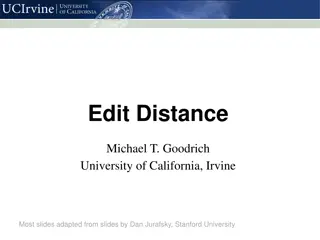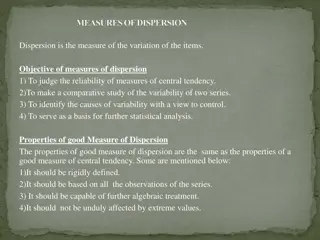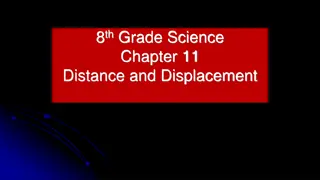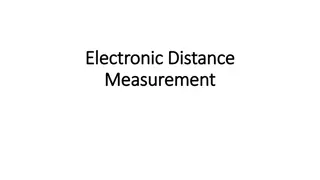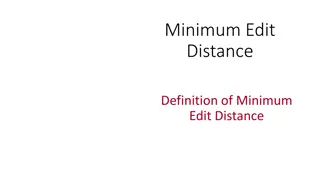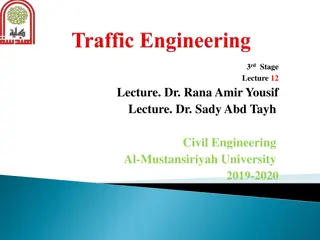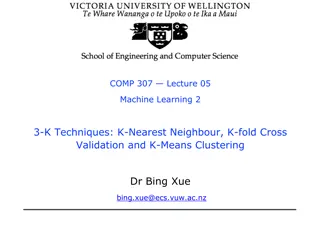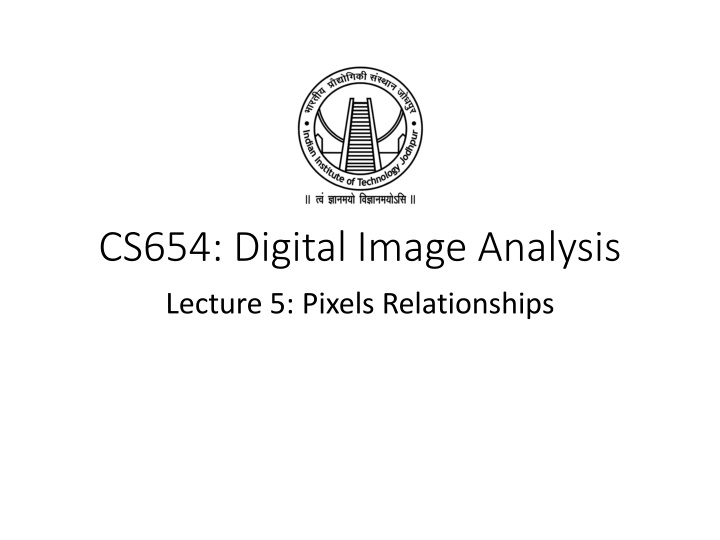
Pixels Relationships in Digital Image Analysis
Explore the concepts of pixels relationships, different distance measures, and the application of these measures in digital image analysis. Learn about foreground and background regions, distance functions, and distance formulas such as Euclidean Distance and City-Block Distance.
Download Presentation

Please find below an Image/Link to download the presentation.
The content on the website is provided AS IS for your information and personal use only. It may not be sold, licensed, or shared on other websites without obtaining consent from the author. If you encounter any issues during the download, it is possible that the publisher has removed the file from their server.
You are allowed to download the files provided on this website for personal or commercial use, subject to the condition that they are used lawfully. All files are the property of their respective owners.
The content on the website is provided AS IS for your information and personal use only. It may not be sold, licensed, or shared on other websites without obtaining consent from the author.
E N D
Presentation Transcript
CS654: Digital Image Analysis Lecture 5: Pixels Relationships
Recap of Lecture 4 Different pixel relationships Neighbourhood Connectivity Adjacency Path Connected component labelling
Outline Different distance measures Application of distance measures Arithmetic and logical operations on images
Region and boundary A region is a set of pixels in which there is a path between any pair of pixels Points within a region are contiguous: reflexive, symmetric and transitive Decomposition of set Connected component labeling
Foreground and background Let ??are disjoint regions in an image Let ? = ?=1, ,???, where ? = number of disjoint sets ??= set complement to ? Background, and holes Simple contiguous region, multiple contiguous region
Distance Measures For pixels p, q and z, with coordinates (x,y), (s,t) and (v,w), respectively, D is a distance function if: (a) D (p,q) 0 (D (p,q) = 0 iff p = q), (b) D (p,q) = D (q, p), and (c) D (p,z) D (p,q) + D (q,z).
Distance Measures The Euclidean Distance between p and q is defined as: De(p,q) = [(x s)2 + (y - t)2]1/2 Pixels having a distance less than or equal to some value r from (x,y) are the points contained in a disk of radius r centered at (x,y) q (s,t) p (x,y)
Distance Measures The D4 distance (also called city-block distance, Manhattan distance) between p and q is defined as: D4 (p,q) = | x s | + | y t | Pixels having a D4 distance from (x,y), less than or equal to some value r form a Diamond centered at (x,y) q (s,t) D4 p (x,y)
Distance Measures Example: The pixels with distance D4 2 from (x,y) form the following contours of constant distance. The pixels with D4 = 1 are the 4-neighbors of (x,y) 2 2 1 2 2 1 P 1 2 2 1 2 2
Distance Measures The D8 distance (also called chessboard distance) between p and q is defined as: D8 (p,q) = max(| x s |,| y t |) Pixels having a D8 distance from (x,y), less than or equal to some value r form a square Centered at (x,y) q (s,t) D8(b) p (x,y) D8(a) D8 = max(D8(a) , D8(b))
Distance Measures Example: D8distance 2 from (x,y) form the following contours of constant distance. 2 2 2 2 2 2 1 1 1 2 2 1 P 1 2 2 1 1 1 2 2 2 2 2 2
Distance Measures Dm distance: is defined as the shortest m-path between the points. In this case, the distance between two pixels will depend on the values of the pixels along the path, as well as the values of their neighbors.
Distance Measures Example: Consider the following arrangement of pixels and assume that p, p2, and p4 have value 1 and that p1 and p3 can have can have a value of 0 or 1 Suppose that we consider the adjacency of pixels values 1 (i.e. V = {1}) 0 s t q r 0 p 0 0
Distance Measures Cont. Example: Now, to compute the Dm between points p and t Here we have 4 cases: Case1: If q =0 and s = 0 The length of the shortest m-path (the Dm distance) is 2 (p, p2, p4) 0 0 t 0 r 0 p 0 0
Distance Measures Cont. Example: Case2: If q =1 and s = 0 now, qand pwill no longer be adjacent (see m-adjacency definition) then, the length of the shortest path will be 3 (p, q, r, t) 0 0 t q r 0 p 0 0
Distance Measures Cont. Example: Case3: If p1 =0 and p3 = 1 The same applies here, and the shortest m-path will be 3 (p, p2, p3, p4) 0 s t 0 r 0 p 0 0
Distance Measures Cont. Example: Case4: If p1 =1 and p3 = 1 The length of the shortest m-path will be 4 (p, p1 , p2, p3, p4) 0 s t q r 0 p 0 0
Paradoxes 4- connectivity Perpendicular lines not crossing each other
Paradoxes 8- connectivity Perpendicular lines not crossing each other a B d C
Application of distance measure: Shape matching Distance transform is an operator normally only applied to binary images. The result of the transform is a gray-level image that looks similar to the input image Except that the grey level intensities of points inside foreground regions are changed to show the distance to the closest boundary from each point.
Distance transform: Analogy Imagine that foreground regions in the input binary image are made of some uniform slow burning inflammable material. Starting a fire at all points on the boundary of a foreground region and letting the fire burn its way into the interior. Label each point in the interior with the amount of time that the fire took to first reach that point Chamfering algorithm or chamfering or distance function
Distance transform The resulting image has pixel values o 0 for elements of the relevant subset o Low values for close pixel o High values for pixels remote from it The distance transform of a binary image o Distance from each pixel to the nearest non-zero pixel
Example 5 4 4 3 2 1 0 1 0 0 0 0 0 0 1 0 4 3 3 2 1 0 1 2 0 0 0 0 0 1 0 0 3 2 2 2 1 0 1 2 0 0 0 0 0 1 0 0 2 1 1 2 1 0 1 2 0 0 0 0 0 1 0 0 1 0 0 1 2 1 0 1 0 1 1 0 0 0 1 0 1 0 1 2 3 2 1 0 0 1 0 0 0 0 0 1 1 0 1 2 3 3 2 1 0 1 0 0 0 0 0 0 1 0 1 2 3 4 3 2 0 1 0 0 0 0 0 0 Distance transform for distance D4
Two pass distance transform algorithm Proposed by Rosenfeld and Pfaltz for distance D4 and D8 Idea: traverse the image by a small local mask Pass 1: Starts from top left corner of the image Move horizontally left to right Move vertically top to bottom Pass 2: Starts from bottom right corner of the image Move horizontally right to left Move vertically bottom to top
Masks use for distance transform calculation AL AL BR AL P P BR AL BR BR Mask used for pass 1 Mask used for pass 2 Pixel neighbourhoods used in DT P is the central pixel The effectiveness comes from the propagation of values in a wave like manner
The DT Algorithm Step 1: For a subset ? of an image of dimension ? ? with respect to a distance metric ?, construct an ? ? array ? with elements corresponding to the set ? set to 0, and all other elements set to infinity. Step 2: Pass through the image row by row, from top to bottom and left to right. For each neighbouring pixel above and to the left ? ? = min ? ?? (? ? ,? ?,? + ? ? ) Step 3: Pass through the image row by row, from bottom to top and right to left. For each neighbouring pixel below and to the right ? ? = min ? ??(? ? ,? ?,? + ? ? ) Step 4: The array ? now holds a chamfer of the subset ?.
Arithmetic operations on Images An image is represented in a matrix format. To perform image arithmetic the size of the two matrices should be same. The operation on two images results in a new image. Consider two images A and B with same size. Image Addition add components from one image into other image Image Subtraction change detection Image Multiplication masking Image Division
Logical operation on images Logical operations are done on pixel by pixel basis. The AND and OR operations are used for selecting sub- images in an image . This masking operation is referred as Region Of Interest processing. Isolate image parts Logical AND Logical OR
Thank you Next Lecture: Basic transformations



